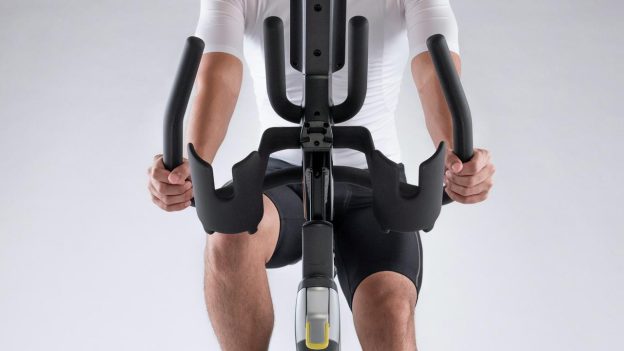Stationary bikes have long been recognized as an excellent tool for indoor exercise, offering a plethora of benefits ranging from cardiovascular health to muscle building, all while minimizing the impact on joints. However, to truly maximize the benefits of your exercise bike workouts, it’s essential to understand how to properly set up your bike, follow correct posture and form, establish a consistent routine, and select the right type of bike for your fitness goals. In this comprehensive guide, we’ll delve into each of these aspects to help you get the most out of your exercise bike experience.
Understanding the Types of Stationary Bikes

Photo by David Marioni on Unsplash
Stationary bikes come in various forms, each catering to different preferences and fitness goals. Traditional upright bikes mimic the feel of outdoor cycling, with a higher-set handlebar and a more vertical frame that keeps the rider seated throughout the workout. These bikes often feature LCD displays and magnetic resistance systems, allowing users to monitor their progress and adjust intensity levels.
Spin bikes, on the other hand, offer a more intense workout experience, with lower-set handlebars that encourage forward-leaning positions and occasional standing pedaling. Operated using a flywheel and friction resistance system, spin bikes simulate outdoor cycling conditions and are popular among enthusiasts seeking high-intensity interval training (HIIT) sessions.
Recumbent bikes provide a reclined seating position, making them ideal for individuals with back pain or mobility issues. With a wider, cushioned seat and lower pedal placement, recumbent bikes offer a more comfortable and ergonomic riding experience while still providing effective cardiovascular exercise.
Folding indoor bikes offer convenience and space-saving features, making them suitable for users with limited space or those who prefer portable exercise equipment. While they may lack some of the advanced features of other stationary bikes, folding bikes still deliver effective cardio workouts at an affordable price point, making them a practical choice for many users.
Proper Bike Setup
Setting up your exercise bike correctly is essential to optimize comfort, performance, and safety during your workouts. Start by adjusting the saddle angle to ensure it’s level, providing adequate support for your body weight without causing discomfort or pressure points. Avoid excessive upward or downward tilt, which can lead to discomfort and potential injury during prolonged use.
Next, adjust the seat height to achieve proper leg extension while pedaling. With your biking shoes on, place the balls of your feet on the pedals and ensure that your front leg is almost fully extended with a slight bend in the knee. This position minimizes strain on the knees and promotes efficient pedaling mechanics, allowing you to generate power without overexertion.
Additionally, fine-tune the seat fore/aft position to align your knees directly over the pedal axles when pedaling. This ensures optimal biomechanics and reduces the risk of knee pain or injury. Similarly, adjust the handlebar height and position to maintain a comfortable reach and proper upper body alignment, allowing you to ride with ease and efficiency.
Finally, ensure that pedal clips or straps are adjusted snugly around the balls of your feet, allowing for a secure connection and optimal power transfer throughout each pedal stroke. By meticulously adjusting your bike setup according to your body measurements and riding preferences, you can create an ergonomic and personalized riding experience that enhances your overall workout performance.
Correct Posture and Form

Photo by Intenza Fitness on Unsplash
Maintaining proper posture and form is crucial for maximizing the effectiveness of your stationary bike workout and minimizing the risk of injury. Start by sitting on the widest part of the saddle and hinging forward at the hips to reach the handlebars, engaging your abdominal muscles to support your upper body.
Ensure that your spine remains straight and aligned throughout the workout, avoiding slumping or arching of the back. Keep your shoulders relaxed and neutral, with elbows slightly bent and close to your body. This posture promotes optimal upper body stability and allows for efficient power generation through the legs.
Avoid leaning excessively on the handlebars, as this can offload weight from the pedals and reduce the effectiveness of the workout. Instead, focus on distributing your weight evenly between the saddle and pedals, engaging your core muscles to maintain balance and stability.
Keep your feet flat on the pedals and avoid pointing your toes downward, as this can increase pressure on the knees and lead to discomfort or injury. Drive through each pedal stroke from the ball of your foot, maintaining a smooth and controlled motion throughout the entire revolution.
By following these guidelines for correct posture and form, you can optimize your stationary bike workout for maximum efficiency, comfort, and safety. Consistently practicing good posture habits will not only enhance your cycling performance but also reduce the risk of overuse injuries and discomfort associated with poor form.
Establishing a Consistent Routine
Consistency is key to achieving meaningful results from your stationary bike workouts. By establishing a regular exercise routine and dedicating specific time slots for cycling sessions, you can cultivate healthy habits that support your fitness goals and overall well-being.
Begin by scheduling your workouts at times that align with your daily routine and personal preferences. Whether it’s early morning rides to kickstart your day or evening sessions to unwind after work, choose times that you’re most likely to adhere to consistently.
Set realistic goals for your exercise bike workouts, taking into account factors such as duration, intensity, and frequency. Start with manageable targets that challenge you without overwhelming your schedule or fitness level. As you progress, gradually increase the duration or intensity of your rides to continue challenging yourself and driving improvements in your fitness.
Stay accountable by tracking your progress and celebrating your achievements along the way. Whether it’s logging your workout data, setting milestones to work towards, or rewarding yourself for reaching specific goals, find ways to stay motivated and engaged with your exercise routine.
Incorporate variety into your workouts to keep things interesting and prevent boredom or burnout. Experiment with different ride durations, intensity levels, and training programs to challenge your body in new ways and avoid plateaus in your progress.
By establishing a consistent exercise routine and adhering to it diligently, you can harness the full potential of your stationary bike and reap the numerous health and fitness benefits it offers. Consistency is the cornerstone of success in any fitness endeavor, so commit to making exercise a regular and non-negotiable part of your lifestyle.
Enhancing Enjoyment and Motivation

Photo by Intenza Fitness on Unsplash
Finding ways to make your exercise bike workouts more enjoyable and engaging can help boost motivation and adherence to your fitness routine. Incorporate elements of enjoyment into your workouts to make them more sustainable and fulfilling, ensuring that you look forward to each session.
Music can be a powerful motivator during exercise, so create a playlist of upbeat songs that energize and inspire you. Choose music with a fast tempo that matches your cycling cadence, allowing you to ride in rhythm and maintain momentum throughout your workout.
Change up your scenery by watching scenic videos or virtual cycling routes that simulate outdoor rides.
Final Word
Maximizing your workout on an exercise bike requires attention to detail, consistency, and a thorough understanding of proper techniques and equipment. By following the guidelines outlined in this comprehensive guide, you can elevate your stationary biking experience and achieve your fitness goals effectively and safely. Whether you’re a seasoned cyclist or a beginner, implementing these strategies can help you get the most out of your exercise bike workouts and enjoy a healthier, fitter lifestyle.







